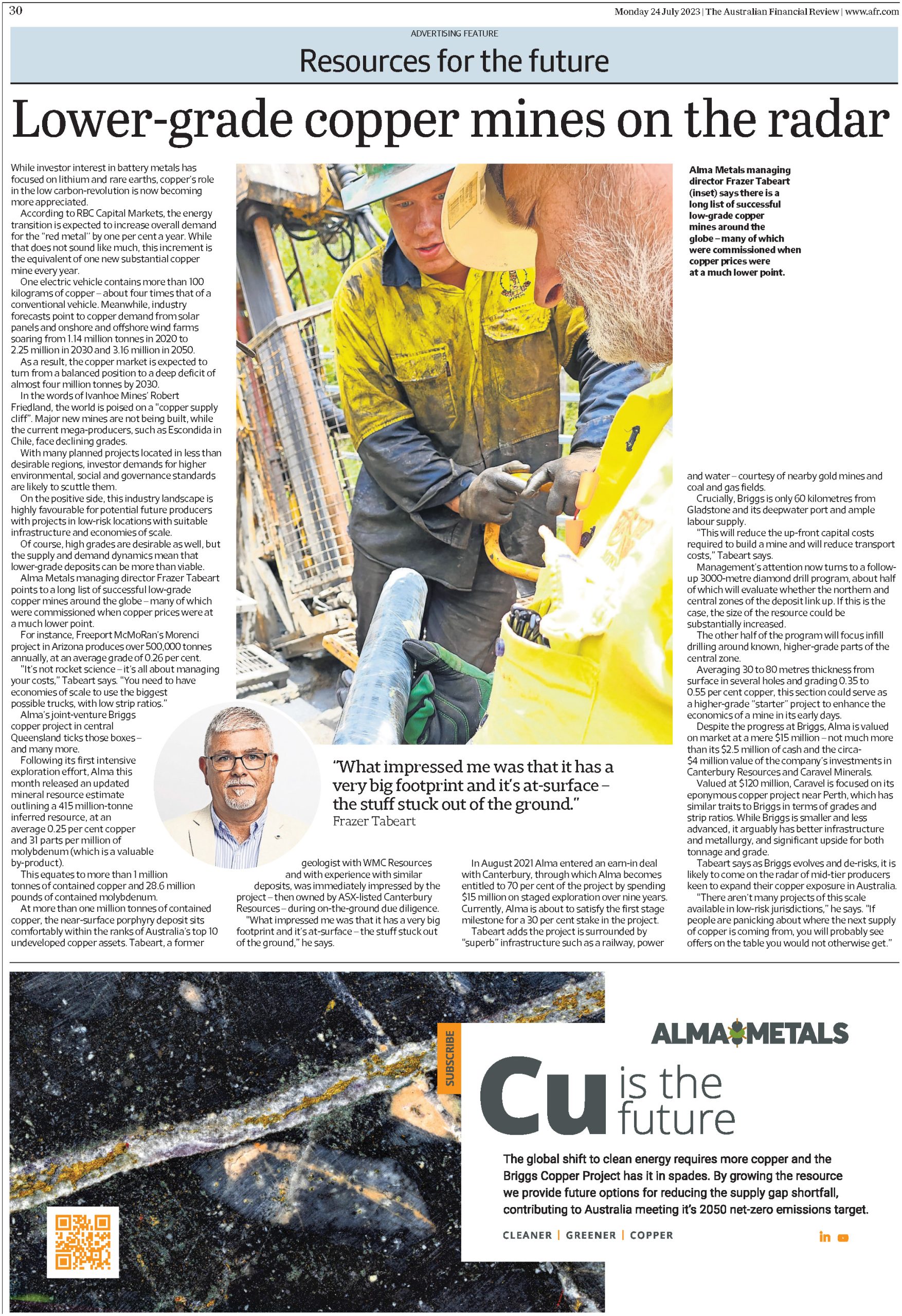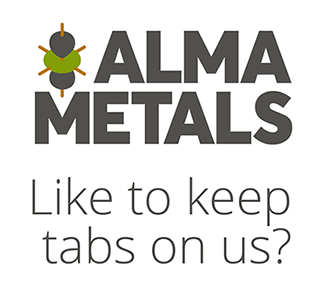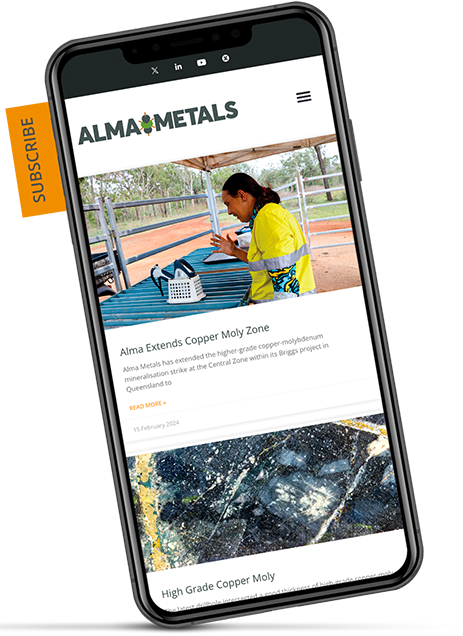Australian Financial Review

FEATURE AD
Monday 24 July 2023

Resources for the future
Lower-grade copper mines on the radar
A change in strategy appears to be close to paying dividends for Alma Metals after it read the global energy tea leaves and shifted from African coal to instead zero in on a big Queensland copper find.
According to RBC Capital Markets, the energy transition is expected to increase overall demand for the ‘‘red metal’’ by one per cent a year. While that does not sound like much, this increment is the equivalent of one new substantial copper mine every year.
One electric vehicle contains more than 100 kilograms of copper – about four times that of a conventional vehicle. Meanwhile, industry forecasts point to copper demand from solar panels and onshore and offshore wind farms soaring from 1.14 million tonnes in 2020 to 2.25 million in 2030 and 3.16million in 2050.
As a result, the copper market is expected to turn from a balanced position to a deep deficit of almost four million tonnes by 2030.
In the words of Ivanhoe Mines’ Robert Friedland, the world is poised on a “copper supply cliff”. Major new mines are not being built, while the current mega-producers, such as Escondida in Chile, face declining grades.
With many planned projects located in less than desirable regions, investor demands for higher environmental, social and governance standards are likely to scuttle them.
On the positive side, this industry landscape is highly favourable for potential future producers with projects in low-risk locations with suitable infrastructure and economies of scale.
Of course, high grades are desirable as well, but the supply and demand dynamics mean that lower-grade deposits can be more than viable.
Alma Metals managing director Frazer Tabeart points to a long list of successful low-grade copper mines around the globe –many of which were commissioned when copper prices were at a much lower point.
For instance, Freeport McMoRan’s Morenci project in Arizona produces over 500,000 tonnes annually, at an average grade of 0.26 per cent.
“It’s not rocket science – it’s all about managing your costs,” Tabeart says. “You need to have economies of scale to use the biggest possible trucks, with low strip ratios.”
Alma’s joint-venture Briggs copper project in central Queensland ticks those boxes – and many more.
Following its first intensive exploration effort, Alma this month released an updated mineral resource estimate outlining a 415 million-tonne inferred resource, at an average 0.25 per cent copper and 31 parts per million of molybdenum (which is a valuable by-product).
This equates to more than 1million tonnes of contained copper and 28.6 million pounds of contained molybdenum.
At more than one million tonnes of contained copper, the near-surface porphyry deposit sits comfortably within the ranks of Australia’s top 10 undeveloped copper assets. Tabeart, a former geologist with WMCResources and with experience with similar deposits, was immediately impressed by the project – then owned by ASX-listed Canterbury Resources – during on-the-ground due diligence.
What impressed me was that it has a very big footprint and it’s at-surface – the stuff stuck out of the ground.”
Alma Metals managing director Frazer Tabeart Tweet
In August 2021 Alma entered an earn-in deal with Canterbury, through which Alma becomes entitled to 70 per cent of the project by spending $15 million on staged exploration over nine years. Currently, Alma is about to satisfy the first stage milestone for a 30 per cent stake in the project.
Tabeart adds the project is surrounded by ‘superb’ infrastructure such as a railway, power and water – courtesy of nearby gold mines and coal and gas fields.
Crucially, Briggs is only 60 kilometres from Gladstone and its deepwater port and ample labour supply.
“This will reduce the up-front capital costs required to build amine and will reduce transport costs,” Tabeart says.
Management’s attention now turns to a followup 3000-metre diamond drill program, about half of which will evaluate whether the northern and central zones of the deposit link up. If this is the case, the size of the resource could be substantially increased.
The other half of the program will focus infill drilling around known, higher-grade parts of the central zone.
Averaging 30 to 80 metres thickness from surface in several holes and grading 0.35 to 0.55 per cent copper, this section could serve as a higher-grade ‘‘starter’’ project to enhance the economics of a mine in its early days.
Despite the progress at Briggs, Alma is valued on market at a mere $15 million – not much more than its $2.5million of cash and the circa-$4 million value of the company’s investments in Canterbury Resources and Caravel Minerals.
Valued at $120 million, Caravel is focused on its eponymous copper project near Perth, which has similar traits to Briggs in terms of grades and strip ratios. While Briggs is smaller and less advanced, it arguably has better infrastructure and metallurgy, and significant upside for both tonnage and grade.
Tabeart says as Briggs evolves and de-risks, it is likely to come on the radar of mid-tier producers keen to expand their copper exposure in Australia.
“There aren’t many projects of this scale available in low-risk jurisdictions,” he says. “If people are panicking about where the next supply of copper is coming from, you will probably see offers on the table you would not otherwise get.”






